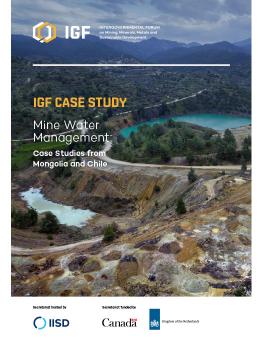
IGF Case Study: Mine Water Management
Case Studies from Mongolia and Chile
As a significant user of water resources and a source of potential contaminants, mining requires effective governance at the watershed scale. These case studies show how two jurisdictions are evolving and making improvements.
Water is essential to the mining industry. Moreover, access to clean water is a human right and a valuable cultural, economic, and environmental resource. This interdependency makes water security and sustainable development around water resources a shared interest among users—a topic most effectively managed at the watershed scale.
As a significant user of water resources—for ore processing, cleaning, maintenance, and staff use—and as a source of potential contaminants, mining requires effective governance at the watershed scale. Companies typically need to spend a considerable amount of time, energy, and resources managing the water that comes into and flows out of their operations. This includes constantly controlling and managing any excess water (such as rainfall, runoff, or groundwater) that may come in contact with mine operations. Governments working with mining companies to ensure that water resources are properly and effectively managed will help balance the company’s needs with those of other users, including the most vulnerable, while minimizing the risk of tensions and conflict between competing users.
Significant risks to water security remain a reality in many mining jurisdictions, and if left unaddressed, these risks will only increase in the context of climate change. The impacts of climate change on water quality and availability within a watershed—a function of increasing rainfall variability, rising temperature, and intensifying extreme weather events—will directly impact all users.
Governments are uniquely placed to manage water resources at the watershed scale. This stands in contrast to the individual users, who can only manage their actions around water within the footprint of their control. The key objective with respect to mining governance within the context of watershed-level management is to ensure that mine water management practices fit within the broader management of the watershed’s hydrology, hydrogeology, ecosystems, water users, cultural values, and risks to the sustainability of each. Through a holistic, long-term approach, governments can promote sustainable development in the mining sector within the larger watershed context. More support can be found in the Intergovernmental Forum on Mining, Minerals, Metals and Sustainable Development’s (IGF) 2021 Guidance for Governments: Environmental Management and Mining Governance.
Good governance is founded on strong legal frameworks. Governments should strive to build legal frameworks that aim to incorporate international standards and best management practices built on the experience of other jurisdictions. This is, of course, not without its challenges. One long-standing legal challenge for managing water is that it is a common resource with often uncertain ownership and rights. Granting rights to nature is an emerging trend in national legal frameworks, originating from Indigenous views of the rights of nature. Bolivia has granted nature rights in its Laws on the Rights of Mother Nature, and Ecuador granted rights to Mother Earth in its constitution in 2008. Legal rights have also been granted to the Atrato River in Colombia, the Ganges and Yamuna rivers in India, and the Whanganui River in New Zealand. Legal rights allow the river to litigate for damages from pollution or use. Representatives such as individuals or communities can then work to enforce the rivers’ rights.
Mongolia and Antofagasta, Chile, are two jurisdictions where governments have developed watershed-level management frameworks for their water resources. Mongolia’s framework started at the country-wide level and divided up administration into management basins. Chile’s water management framework is administered by states at the regional level. Mining is a crucial part of these frameworks; it plays an important role in both jurisdictions’ economies, places a high demand on water use in arid environments, can generate conflicts with other water users, and is a potential source of contaminants.
Following an overview of important components of watershed management, the two case studies show how each jurisdiction has evolved and is making improvements.
You might also be interested in
Women and the Mine of the Future
Uncovering the gender-disaggregated employment profile for large-scale mining, focusing on women and their occupations in 12 countries.
IGF Case Study: Mine Closure Policies in South America
These IGF case studies examine mine closure legislation in Chile and Peru.
IGF Case Study: Decarbonization of the Mining Sector
Case studies from Chile, Indonesia, and South Africa that delve into the role of the mining sector in efforts to reduce greenhouse gas (GHG) emissions.
2023 IGF Annual Report
Detailing an eventful year that saw the IGF Secretariat deliver several new publications, workshops, and events for its growing membership.